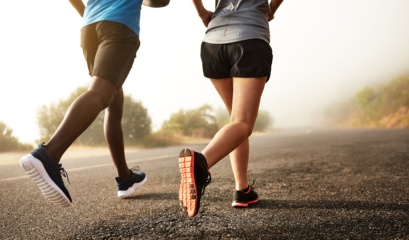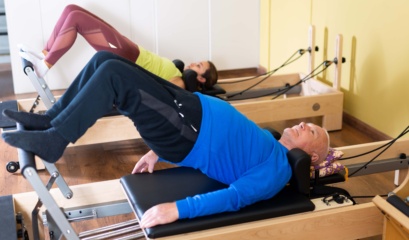Are you suffering from lower back pain? This article walks you through 13 exercises for lower back pain to try and get you back up and running!
You’re Not Alone
Lower back pain is the most common issue we see as physiotherapists, so we know how debilitating it can be. We recently featured a post on the ‘8 Top Tips to Relieve Lower Back Pain’ discussing simple everyday tips to help reduce your back pain, but decided we wanted to go further and provide our clients with some specific exercises that we’ve seen work wonders in our clinics time and time again. And with 619 million people suffering from back pain worldwide according to the WHO, you should know that you’re not alone.
Exercises for lower back pain are something that should be included in your daily routine, particularly if you are experiencing pain such as sciatica or stiffness, or if you’re starting to get older, which, sadly, is one of the many causes of lower back pain. These exercises don’t have to take up much of your time. Just as brushing your teeth twice a day is a great way to prevent dental problems, stretching and strengthening your back will benefit you into your 40s, 50s, 60s and beyond, ensuring your back muscles don’t lose strength and your spine maintains its flexibility.
Be sure to start slow and monitor your pain as you perform these lower back pain exercises! If you need a physio in Sydney to help with your pain, book an appointment. We even provide online physiotherapy services if you’re from further afield!
Ther 13 Best Exercises and Stretches for Lower Back Pain
1. Knee to Chest

Laying on your back, gently pull your knees to your chest, hold for a second or so, and release, repeating the movement in a pulsing manner. Do this for about 20 seconds at a time, release, and repeat up to 5 times. You can perform the whole sequence up to 3 times per day.
2. Knee Rotation

With your feet on the ground, bend your knees and gently move them from side to side in a windscreen wiper motion. This exercise for lower back pain works by gently rotating your lumbar spine. Rotate to each side 10 times and perform up to 3 times per day. Be sure to do this slowly, and don’t push through any pain – this should be a gentle, comfortable movement.
3. Extensions
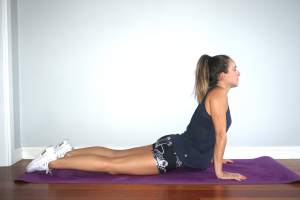
Laying on your stomach, gently press up and extend your lower back. Do not hold this, but repeat the movement 10 times, for three sets, up to three times per day. If this stretch feels too intense, you can adjust it by resting on your forearms or simply not extending it fully.
4. Lower back rotation

Tuck one foot behind the other knee, then gently pull that knee across. Hold the stretch at a comfortable position for 20 seconds, only placing your top knee on the ground if it is comfortable to do so. Repeat 5 times each leg, and perform up to 3 times per day.
5. Cat/Cow

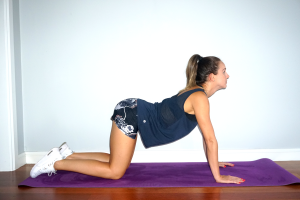
To perform the cat/cow exercise, start on your hands and knees, and then gently curve and flatten your mid back 20 times. Repeat this up to 3 times a day. This one is a great way to start your day!
6. Child’s Pose
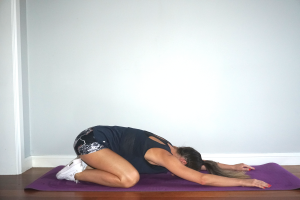
Start with your knees apart and toes touching. Reach out in front of you and sit your bum back towards your heels. Hold this pose for 30 seconds. Repeat this 3 times for one set, and perform up to 3 sets per day. This should be a gentle stretch and can be a great option if your pain is quite severe.
7. Foam rolling
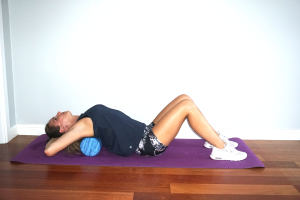
Foam rolling is a great way to loosen tight muscles in the back that might exacerbate lower back pain. Place the foam roller under your mid back, keep your backside on the ground, and gently extend your spine backward. Hold for 30 seconds at a time, and repeat throughout the day as and when needed.
8. Pelvic Tilts
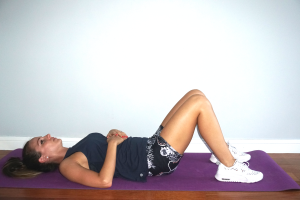
Laying on your back, arch your lower back, then flatten it into the ground, keeping your mid-back on the floor and not extending the hips (this is a small movement that you should feel in your core). Perform this 30 times and repeat as many times as needed throughout the day.
9. Spiky ball roll on glutes
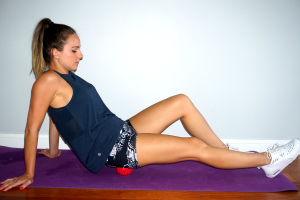
Use a spiky ball to roll out tight muscles in your glutes. Roll the ball around the fleshy part of your buttock for 30 – 60 seconds at a time. The glutes and lower work closely together and so pain or stiffness in one can cause issues in the other!
10. Hip flexor stretches
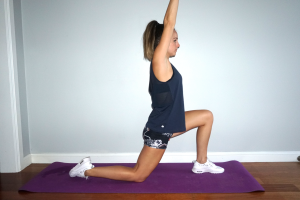
This will stretch out the front of your hip. Get into a low lunge position and hold the stretch for 30 seconds, repeating 5 times each leg. Perform up to 5 sets per day.
11. Piriformis stretches

This is a strong stretch for your glutes and hips and may be difficult if your pain is severe. Place one leg onto your other thigh in a figure four shape, and gently lower your buttock to the ground. Hold for 20 seconds. Repeat each leg 5 times, up to 5 times per day, being sure not to push through any pain.
12. Thread the needle
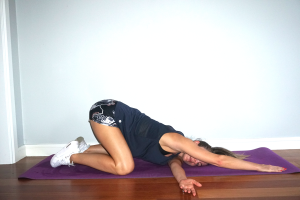
In a similar position to downward dog but on your knees, reach your arm through to give your mid-back a stretch. Hold for 30 seconds. Repeat 5 times each side, and up to 5 times per day.
13. Hamstring stretches
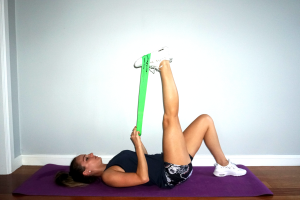
Lay on your back, with one leg bent and one leg in the air with a stretch band around your foot. Hold for 30 seconds, repeat both legs 5 times, and repeat up to 3 times per day.
How to Prevent Lower Back Pain From Coming Back
Whilst these exercises for lower back pain should help, it’s important to understand why the pain is occurring in the first place.
A physiotherapist will help determine the root cause of the problem and set out a specific program tailored to your needs to ensure you get the best outcomes.
Lower back pain can easily be put down to the ageing process and although there is some truth to that, the amount of stiffness you feel does not have to relate to how old you are. We’ve seen many 50-year-olds come into our clinic with healthier spines than 20-year-olds due to consistent and dedicated care and exercise.
As you age, the fluid that lubricates the joints decreases, cartilage thins and muscles tighten. However, there can be other factors at play when it comes to back pain and stiffness.
- Dehydration can lead to stiff muscles. Muscles are active tissues, which means they’re the kind of tissue that require the most water in the body. So be sure to drink enough water.
- Inactivity is another culprit leaving your muscles sedentary for a prolonged period (sleep, sitting in a chair, driving for hours etc.) can cause them to stiffen so try to keep moving.
- Stress causes our bodies to tighten up with prolonged stress leading to a tight posture and strain on the muscles.
- Poor lifting technique is of course another major cause of lower back pain. Be sure to bend your knees, take a deep breath, and brace, whenever lifting anything even remotely heavy off of the ground.
On top of all this, there may be underlying physical problems that can shape the appropriate treatment plan, so talking to your doctor or a professional physiotherapist (like us) can really help things along. If you’d like to know more about how we can help, contact us and we’d be happy to welcome you to our nearest practice.





